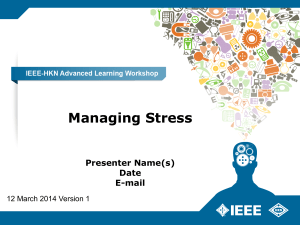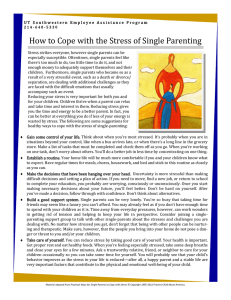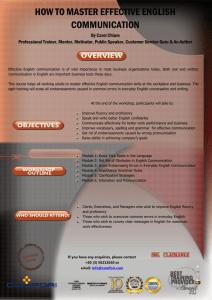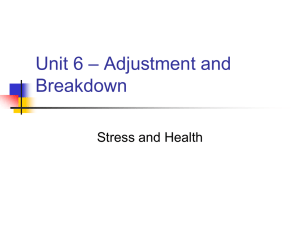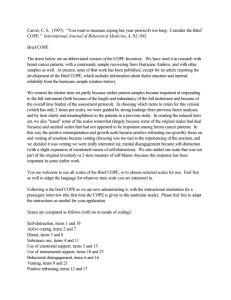STRESS MANAGEMENT
advertisement
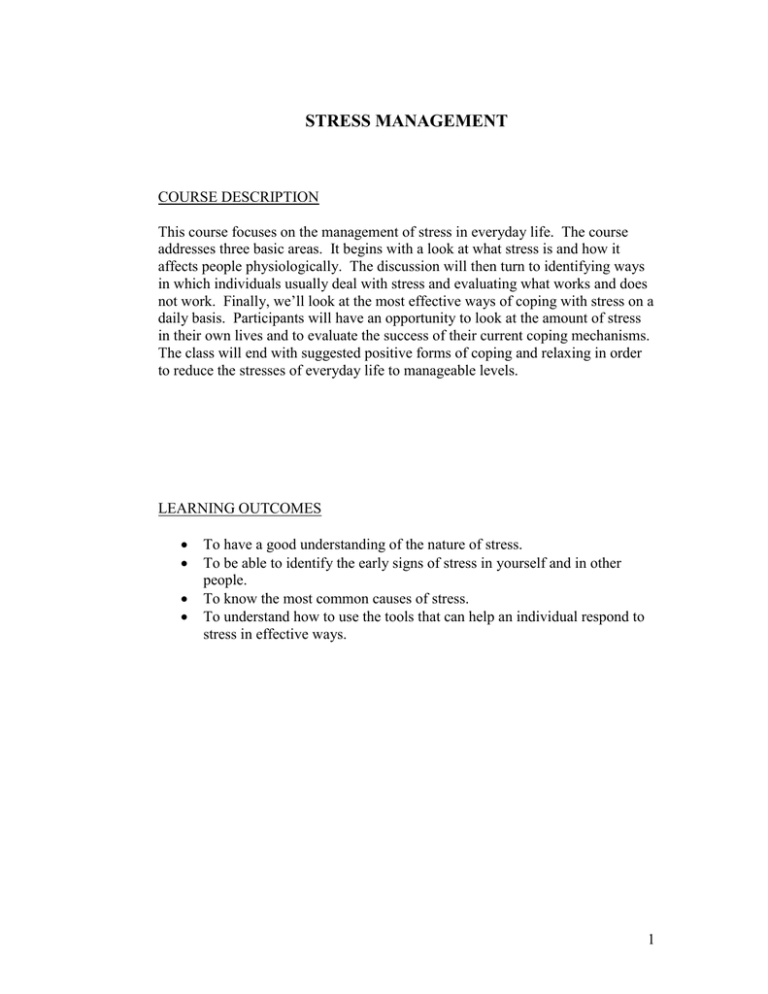
STRESS MANAGEMENT COURSE DESCRIPTION This course focuses on the management of stress in everyday life. The course addresses three basic areas. It begins with a look at what stress is and how it affects people physiologically. The discussion will then turn to identifying ways in which individuals usually deal with stress and evaluating what works and does not work. Finally, we’ll look at the most effective ways of coping with stress on a daily basis. Participants will have an opportunity to look at the amount of stress in their own lives and to evaluate the success of their current coping mechanisms. The class will end with suggested positive forms of coping and relaxing in order to reduce the stresses of everyday life to manageable levels. LEARNING OUTCOMES To have a good understanding of the nature of stress. To be able to identify the early signs of stress in yourself and in other people. To know the most common causes of stress. To understand how to use the tools that can help an individual respond to stress in effective ways. 1 PURPOSE OF THE COURSE The purpose of this course is to provide a practical look at stress, its causes, and some stress reducers. FOCUS OF THE COURSE This course focuses on how to manage stress in everyday life without “burning out” or giving up. COURSE OUTLINE I. Introduction to Stress A. What is stress? B. What causes stress? C. How can stress be identified? II. A Closer Look at the Causes of Stress A. Social conditions B. Communications media C. Push to achieve D. Pressure to overreach III. Signs of Stress Buildup A. How to recognize the signs of stress in yourself B. Possible signs of stress in others IV. Responding to Stress A. Three major ways we cope with stress B. Defense mechanisms C. Living with the stress we can’t get rid of 2 AN INTRODUCTION TO STRESS What is stress? STRESS – a word that has captured the country by storm and is used daily by most of us to express our frustrated state of being. Stress, as defined by Hans Selye, is the physiological response of the body to any (good or bad) change in the environment. How do you identify stress in yourself? A. What do you do? B. How do you feel? Some specific causes of stress: 3 STRESS BUILD-UP As stress builds up in your life, physical indicators such as headaches and ulcers will let you know that things are getting out of hand. There are also sociological and psychological indicators of an increase in stress. SIGNS OF STRESS BUILD-UP INCLUDE: 1. You feel like you just can’t cope. 2. Everything needs to be done at the same time. 3. You find yourself putting everything and everyone else first, second, third, . . . and yourself LAST! 4 It is also important to know specific symptoms for identifying stress in others. Think about the people you work with, your loved ones at home, and those special friends in your life. If you notice unusual behaviors – changes from the way they have behaved in the past – it is possible that they may have some stressful situations in their lives. It might be helpful for you to let them know that you have noticed these changes and to suggest that they at least think about situations in their lives right now that have not been resolved. Remember, one or two symptoms may mean nothing. You should be concerned only when you notice three or four (or more) of these symptoms that demonstrate a change in that person’s behavior. Some people always exhibit the kinds of behaviors identified as “symptoms” of stress. IDENTIFIABLE SYMPTOMS OF STRESS Psychological: 1. 2. 3. Withdrawal from others Suspicion of others Personal feelings of worthlessness Physical: 1. 2. 3. 4. 5. 6. High blood pressure Muscle tension and headaches Change in appetite Upset stomach Restlessness Change in sleep patterns Sociological: 1. 2. 3. 4. 5. 6. Decreased productivity Lowered concentration (forgetfulness) Reduced energy Accident prone Absences from work Increased dependencies 5 Now take a moment to evaluate just how much stress you have in your life right now. The line below is called Your Personal Stress Line. 1. Think about your life right now. Not just this very second, but in general, over the past few months. Consider your work environment, home, social life, and everything that is a part of you. 2. Put an “X” along the line to designate the amount of stress you have. The far left side indicates NO stress at all, and the right side indicates TOTAL stress. The center of the line, or the midpoint, indicates an average amount of stress. How much stress do you have? Mark your “X” on the line below. MY PERSONAL STRESS LINE 0 No Stress Average Stress + Total Stress Quickly – list the main items that came to your mind as you were deciding where to place your “X..” List all of them: personal, business, and social. 6 RESPONDING TO STRESS There are three basic ways all of us cope with stressful situations. Each method has both positive and negative aspects. 1. WITHDRAW: Leave, move away, escape physically or psychologically. Negative Positive 2. CONFORM: Agree to go along with a disagreeable situation. Negative Positive 3. ATTACK: a. With intent to injure or destroy b. In a constructive or positive manner (CONFRONTATION) Negative Positive All of us defend ourselves against difficult situations. The tools we use include defense mechanisms. Which ones do you use most often? 1. 2. 3. 4. 5. 6. 7. 8. Repression: Denial: Isolation: Regression: Introjection: Rationalization: Compensation: Reaction Formation: 7 It is impossible (and not healthy) to rid our lives of all stress. Therefore, we must learn to live with the stress we have. Here are some suggestions for learning to live successfully and comfortably with the stress we cannot end. HOW TO LIVE WITH STRESS 1. Develop a here-and-now life focus. 2. Make use of a group for support. 3. Give up some of your illusions of control. 4. Have some open relationships. 5. Adopt a process view of life rather than an event-centered life. 6. Hold on to your sense of humor. 7. Take responsibility for yourself. 8. Maintain a realistic perspective of life. 9. Get rid of hidden agendas. 10. Get physical exercise, but be sure you enjoy it. 11. Escape for a few moments “when the going get tough.” 12. Practice relaxation exercises. “THINK HAPPY” 8
